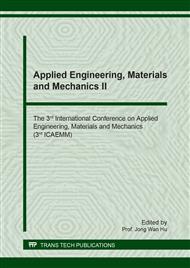p.3
p.10
p.15
p.20
p.25
p.30
p.40
p.46
Preparation and Properties of Poly(Lactic Acid)/Epoxidized Natural Rubber/Nano-Silica Composites
Abstract:
This study aimed to improve the toughness property of poly(lactic acid) (PLA) by incorporating epoxidized natural rubber (ENR), an elastomeric material and silica nanoparticle (nSiO2), a spherical inorganic nanofiller. ENR with 30mol% epoxidation (ENR 30) was first prepared via in situ epoxidation of natural rubber by performic acid generated from the reaction between formic acid and hydrogen peroxide in the latex stage. The PLA was melt blended with three weight percentages (10, 20 and 30wt%) of ENR in an internal mixer, followed by a compression molding. The effects of ENR loadings on the mechanical properties and thermal stability of the blends were first investigated. It was found that the addition of ENR 30 increased the toughness property of the blends. The blend at 20wt% ENR 30 exhibited the highest impact strength and elongation at break, and so was selected for preparing nanocomposites with three loadings (1, 2 and 3 parts per hundred of resins) of nano-silica (nSiO2). The results showed that all PLA/ENR 30/nSiO2 nanocomposites exhibited higher impact strength and thermal stability than the neat 80/20 PLA/ENR 30 blend.
Info:
Periodical:
Pages:
20-24
Citation:
Online since:
July 2018
Price:
Сopyright:
© 2018 Trans Tech Publications Ltd. All Rights Reserved
Share:
Citation:


